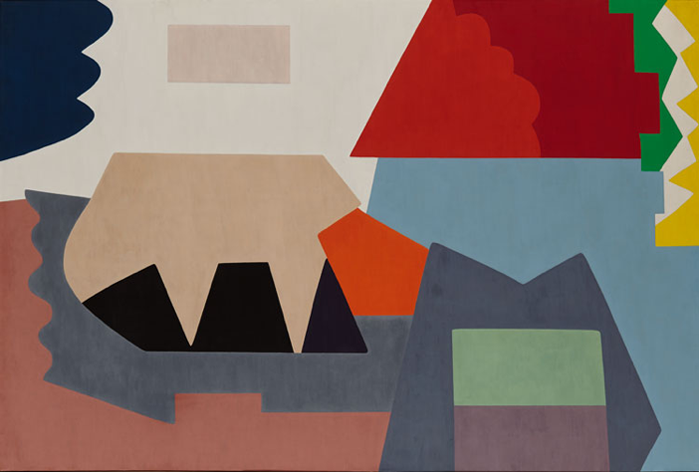Bursting with colors so gorgeous they could have been mixed by Matisse, Shirley Jaffe’s paintings bring a rare excitement to our senses.
The American artist moved to Paris in 1949 and has lived and worked there ever since. Her early works, with thick brush strokes of pigment and strong gestures, were in the style of Abstract Expressionism. Then, in the late 1960’s she began to paint in a very different, more controlled, way. The time spent with each canvas and the application of paint underwent a remarkable transformation.
Matte areas of carefully considered shapes began to be arranged into meticulously studied relationships. Months were spent honing and re-examining each area of distance and connection. This exhibition, of work from the 1970’s, gives us a beautiful, fulsome experience of these explorations. They are, fresh, confident, and timeless.
With barely ten flat colors, The Black Line shows us a highly complex depiction of space. Jaffe has said she is influenced by cities rather than landscape and this is clearly felt in the hard edges and partially obstructed views of various forms. The blues and whites have curves and scallops. There are two linear shapes, one red at the top, one black with ultramarine overtones, dividing the canvas almost in half. Contributing an openness and balance, these lines nearly mirror each other at the top of the frame. There is a playfulness between the various colors. The pink shape coming down from the upper right seems to be a paler version of a darker red shape in the middle. The pale blue around it quietly turns into a sea green of a similar tone.
Crossing street markings could be an inspiration for The First Diagonal. A triangle of lush rose with horizontal yellow stripes divides two areas of the canvas. Another striped area to the right breaks through the rectangular form with white and orange both heightened by trapezoids of bright cerulean. Again there is a contrast, unified by an expert eye, of sharp angles and scalloped edges.
Upside Down-New York is a joyful interpretation of the rhythms and verticality of the city. The canvas is so cleanly proportioned, it almost has the look of a triptych. The left and right areas of many of these canvases have a life of their own. They frame and add movement to a more stable center. Texture has been added with translucent green and cobalt stripes under a large red rectangle on the right, wonderfully balanced by the dynamic flowing shapes on the left.
Jaffe’s love of geometry is matched by her explorations of color. The various large and small triangles of The White Line offer a color chart of dynamic warm and cool tones. Each color is changed, either receding or approaching, by its position to another. A bold off-white diagonal line, its curves growing more intense towards the bottom of the picture plane, connects them as a river does its disparate banks.
The prevalence of semi-opaque pastel colors of mauves, grays, pale green and blue, gives Sylvia’s White a softer presence. Three different black configurations provide an anchor to the floating structures around them. Again, the activity of forms on the left and right edges echoes the equilibrium of relationships. Their position also extends the colors beyond the canvas’ edges in our mind’s eye.
Playing with the tensions between these magnificently colored forms, both curved and angled, Jaffe has invented a language of coexistence. She has brought us to a place that is refreshingly new but somehow, mysteriously, familiar.
By A. Bascove
























